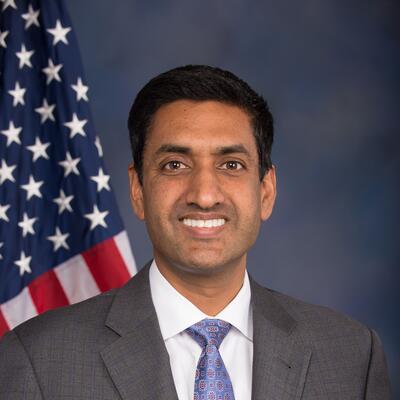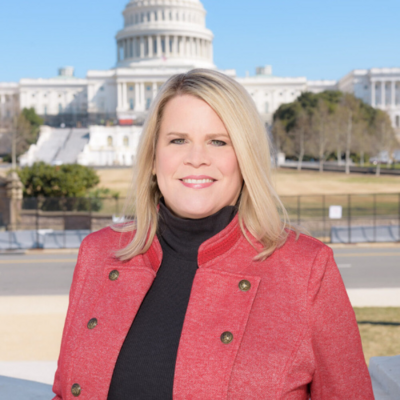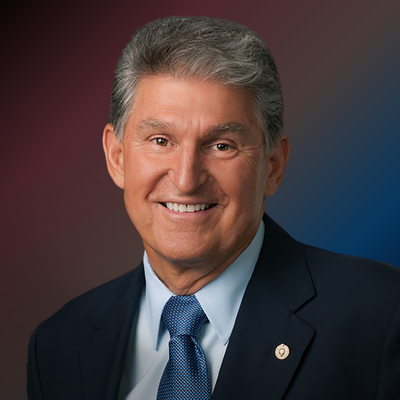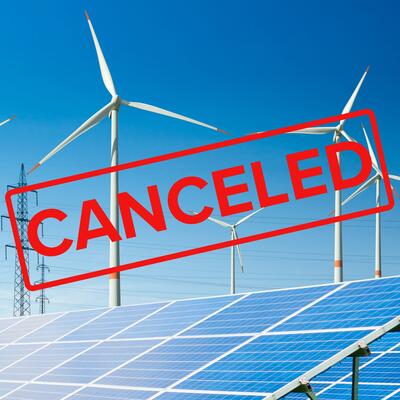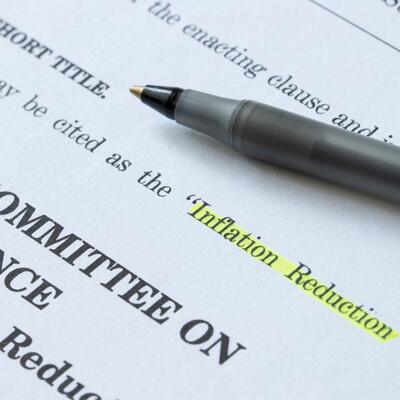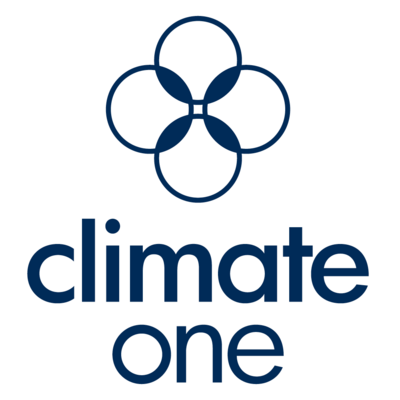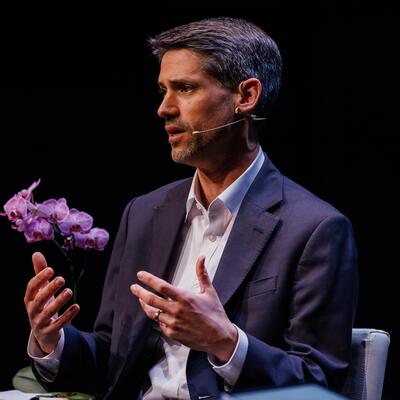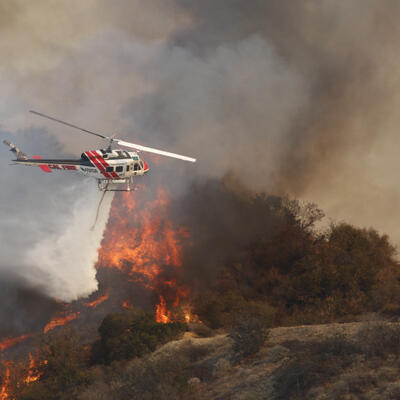
The Big Climate Stories of 2018
Guests
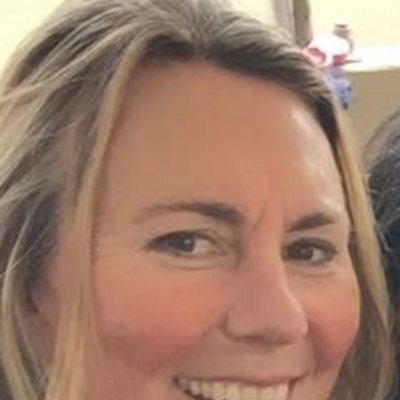
Maggi Kelly
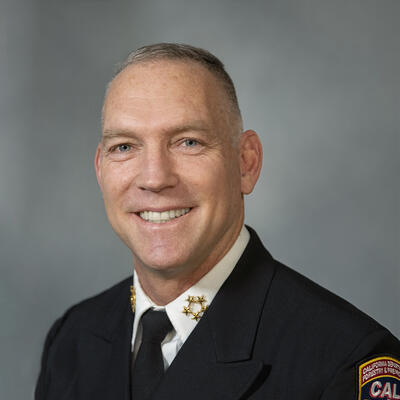
Thom Porter
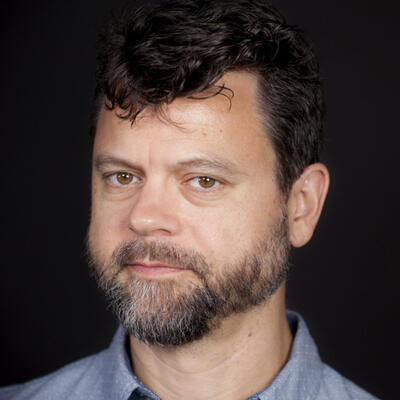
David Roberts
Summary
We’re making a list (and checking it twice) of 2018’s biggest climate stories, with the help of Vox reporter David Roberts. Roberts notes that while President Trump’s continued rollbacks of environmental protections made the news, the Green New Deal and ongoing decline in costs of clean energy technologies are the year’s big stories. For other parts of the country, wildfires and other extreme weather events made the biggest headlines. Greg Dalton talks to some of California’s leading wildfire experts about how to adapt to the “new abnormal” of more intense and more frequent wildfires.
Full Transcript
Announcer: This is Climate One, changing the conversation about energy, the economy, and the environment.
As 2018 comes to a close, what does a climate reporter see as the year’s big stories?
David Roberts: Number one, rolling back regulations, gumming up international climate negotiations. Second is the explosion in the visibility and popularity of a Green New Deal. And, the third story is just sort of the decline in costs of almost all the key clean energy technologies.
Announcer: For those on the frontlines, wildfires and other extreme weather was the big story.
Maggi Kelly: That smoke level over those 10 to 12 days was eye-opening to everybody in a very visceral way.
Thom Porter: Those were career fires for firefighters.
Maggi Kelly: I really think this has been a game changer year.
Announcer: The Breakthrough Stories of 2018. Up next on Climate One.
Announcer: What were the big climate stories of the past year? Climate One conversations – with oil companies and environmentalists, Republicans and Democrats – are recorded at the Commonwealth Club of California, and hosted by Greg Dalton.
I’m Devon Strolovitch. The recent Camp Fire in California’s Butte County, which killed 88 people and burned nearly 14,000 structures, was the most destructive wildfire in the state’s history.
Thom Porter: Within two hours of the start of that fire there were a hundred spot fires starting in downtown Paradise. Our firefighters spent all of their time that first 12 plus hours just keeping the people from being overtaken by the fire
Announcer: Thom Porter is chief of strategic planning at the California Department of Forestry and Fire. He and his CalFire colleagues are the first line of defense for people living on the frontlines. But the Camp Fire wasn’t just a big story for those in immediate danger.
Maggi Kelly: That smoke level over those 10 to 12 days I think really changed all of our minds about fire and just the horror that was coming through the media. It was eye-opening to everybody in a very visceral way.
Announcer: Maggi Kelly is professor of environmental science policy at UC Berkeley. Smoke from the Camp Fire blanketed the San Francisco Bay Area with unhealthy air for nearly two weeks, just a year after wildfires in nearby wine country had caused similar conditions.
Keith Giles: We're going to see other natural hazards hitting us with greater frequency in the same way that we're experiencing fire.
Announcer: Keith Gilles is chair of the California Board of Forestry and Fire Protection, and professor of Forest Economics at UC Berkeley. He joined Maggi Kelly Thom Porter on the Commonwealth Club stage to talk about what became one of the year’s breakthrough climate stories.
But first, Greg sits down with veteran climate reporter David Roberts to ask about the year’s other big stories. Roberts earned a wide following covering climate for Grist. He eventually got so burned out that he walked away from the climate beat for a time, but he’s back now writing some of the most incisive climate articles anywhere for Vox.
Greg Dalton: David Roberts, what are the top climate stories in your view of 2018?
David Roberts: I hate to say this just because I hate to give him more oxygen but, you know, I think you have to go with Trump as the number one. I mean he's rolling back regulations he’s gumming up international climate negotiations as we speak in Poland and just insulting partners and, you know, sort of he’s got Rick Perry, the Department of Energy traveling around the world trying to sell people our fracked gas exports, he’s embraced fossil fuels. I mean, that's like Trump is ten stories in one, but if I can just group them all under him, I would make that the first one. Second, and this is sort of a late-breaking story kind of a late contender but has been really impressive to me is the sort of explosion in visibility and popularity of the concept of a Green New Deal. Which is I think, you know, I think there's been kind of a lack on the left or in the Democratic Party of a big positive climate policy vision since cap and trade, you know, died in 2009 really. There's been some flailing around, but no real consensus on what comes next, or what a big bid ought to be. And I think the Green New Deal has kind of come along and fill that hole like it’s been amazing to me to see people sort of gather around it. And, you know, the third story which I think is slightly boring to point out, but I point it out every year anyways just sort of ongoing mind-boggling decline in costs of almost all the key, especially in electricity of almost all the keys are clean energy technologies. Like no matter how many times we say it, you know, solar still continues to get cheap faster than anyone expects. And that's true for, you know, you’re seeing it this year too in offshore wind which finally arrived in America it was a pretty big deal, and is already getting much cheaper than expected. Batteries storage are getting cheaper, faster than expected. So that's, I don't know this year any particular event this year symbolizes that perfectly but it's ongoing and continuing past where anyone expected it to continue.
Greg Dalton: Let's drill into those. You wrote a story earlier in the year unaffordable clean energy and picked up on some reporting from Nathanael Johnson, at Grist where you used to be, noting that the EPA cited that the affordable clean energy plan, which is the replacement of Obama electricity plan, EPA said it would save $6.4 billion and in compliance costs for energy suppliers. And it also said right there in its report that it would raise health costs by $16-$75 billion. So their own numbers are putting it right there that for those who care to dig into the reports that their numbers are saying that they're going to cause more public harm, but they're going to save some companies and money. They're doing this right out in public.
David Roberts: Yeah, I mean that’s kind of the meta-story of the Trump years isn’t it, is everything that the sort of U.S. conservative movement has been doing and thinking and wanting has been utterly stripped of all pretense, right. So I mean it's been, I mean you don’t even have to dig into the report it’s been well known for years, ever since the EPA starts analyzing how the Clean Air Act is doing, it’s been known for years that restrictions on air pollution pay for themselves many times over in health savings. Like that's been consistently, that’s been a consistent result of every analysis ever in history and it uses government numbers so they don't have any other set of numbers to use, you know. So if they’re gonna rollback pollution regulations that’s what the numbers are gonna say. Now, the one thing I would say is this is one case where you see the lingering effects of competent bureaucracy that preceded Trump, right, like they did good work and they figured out how much air, you know, particulate pollution costs and how much it hurts people and they put that on record. If Trump is in power long enough if he runs the EPA long enough, eventually, he'll get rid of that too, right, I mean he will complete his conversion of the bureaucracy into sort of ideological hacks and then those numbers then they’ll have a different set of numbers, right. But we’re sort of in this weird period where it's a new government, but they're still using a lot of the kind of civil servants and a lot of sort of information that the previous administration generated.
Greg Dalton: There are positive stories you noted that U.S. emissions, greenhouse gas emissions are down 28% from 2005. The range for the Obama clean power plan was of 19% to 32% reduction by 2030. So already the United States despite Trump is meeting the clean power plan that's a very positive story. Despite Trump, the Obama goals are being met even though Trump is attacking them, they’re happening.
David Roberts: Yes. But note that Trump is simultaneously attacking the regulations that produced those declines in emissions and celebrating those declines in emissions as justification for why they don't need to do more, right or why they don't need to stay in the Paris treaty. They sort of taking credit for them even as they try to destroy them. I mean two things. This is not necessarily a story that environmentalists like to hear but the real fact of the matter is that two trends helped -- two or three trends helped reduce emissions in America. One was fracking was the production of an enormous amount of cheap natural gas and that's more than anything else what has killed coal. And then renewables, you know, got so cheap so fast, efficiency always is underestimated and always ended up playing a bigger role than people think it's going to. And so all that stuff kind of came together and this policy was sort of, you know, honestly like air pollution policy or even climate policy or even energy policy is basically a marginal driver compared to those big economic and population and technology trends ultimately have much more effect than these decision. So yes, I mean, it’s incredibly positive that those trends are going in the right direction but you know and I know and the IPCC knows that it's not enough, not fast enough.
Greg Dalton: Right. And some of the macro trends are going in the other directions global emissions are ticking up after being saw for five years. So there are some very troubling signs in the macro numbers that we’re seeing. So on the Green New Deal that has kind of capture the imagination there's a very telegenic charismatic upfront person, person who was working at a restaurant knocked off a senior congressman and now she's the flag carrier and leading sit-ins Nancy Pelosi's office. So let's drill into that one a little bit I mean are we seeing 2008 all over again with green jobs and Van Jones and feel a little bit like I've seen this movie before.
David Roberts: Well, this is where the curse of being in climate policy for long enough is this that there are no new stories left, right. Like you get this fresh wave of young people who come along and say hey maybe let's talk about it from an economic point of view rather than polar bears, I’m like, oh, I wish we had thought of that. But the political reality is you try these things over and over again until they work, right. And it wasn't like the sort of zeitgeist for whatever reason wasn't really ready in 2008 for that message and I don't think that message was really quite coherent and has worked out at that point. And also I think you can't distinguish the Green New Deal as it's playing a role today in politics from the sort of resurgent popularity and power of the left wing of the Democratic Party. Like that's a thing it’s like Van Jones was trying to sort of advance the green jobs narrative within this larger context of kind of caution and the idea that we had these market mechanisms that we had to make, you know, bipartisanship and all the sort of institutional caution that sort of characterized things back then. I think that's mostly gone and so the green jobs message has become something much more muscular and sort of sweeping, you know. There's a huge, huge investment peace now and you have Alexandria Ocasio-Cortez out saying, you know, why should we have to explain how to pay for this, you guys don't explain how to pay for your tax cuts or your giant military bloat, right. This idea that Democrats uniquely have to like take unpleasant medicine alongside anything good they want, you know, she just rejects that and that's new, you know. So I think the program itself has changed a bit and the political circumstances have changed wildly.
Greg Dalton: In fact, you know, that Trent Lott, former Republican Senate leader, Trent Lott and John Breaux another Democratic former Senator who both have represented the oil industry. Trent Lott told the Wall Street Journal earlier this year, “the tide is turning” on this issue there's the Baker-Schultz fee and dividend plan some of the elders of the George H.W. Bush era of Republicans with support from Walmart and others are coming forward with their own plan to price carbon. So does that suggest that this carbon pricing is rising on the agenda on both the left and the right in which there is a potential bipartisan solution on this somewhere a deal to be made?
David Roberts: Well, that’s a real interesting question. I guess what I’d say about the current kind of climate politics landscape is I’ve never seen it so fluid and I've never seen it less clear sort of who's with who and what policy counts as the strong one versus the sort of weak neoliberal sellout policy like no one’s even clear what those categories are in terms of climate policy much very, very fluid. So I would say the one thing to say is the fact that you hear a bunch of oil companies and a bunch of retired Republicans and a lot of, and a small handful even of active Republicans turning around on this issue and supporting a carbon tax is because it's very clear which way the wind is blowing. Like no one, I don't think anyone thinks anymore that five years from now or 10 years from now this issue will have faded away and no one will care anymore, you know what I mean. Like they're not gonna be able to and the sort of just straight denialism that they sort of been winking at and getting away with up to now is not working anymore it's making them look like idiots. So there's a sense among the sort of smarter, more strategic crowd among conservatives and what's left of it that they've got to do something new on this. They need some new position and you sort of see people like kind of Marco Rubio, you know, sort of flailing around looking for the right rhetorical sort of stance. He’s like, you know, we know the climate is changing, right, I’m not a denier, I'm not a denier. We know the climate is changing we’re just not sure how much people play a role which of course as you and I know is a lie that's one thing we’re actually very sure about. And then the second part of the message is all the solutions will destroy the economy, which is always, always their response to any attempt to make the life of American citizens better in any way. And, you know, that as a response to any climate policy is the most predictable thing in the world. But the fact that they're retreating to that, you know, like there’s gonna be a wholesale retreat on the right from the sort of pure intransigence let's say that they've been using up to now. And there's going to have to be some compromise so yeah. And this is a dynamic too that I pointed out in a different article but I think is really important and interesting to understand is precisely those Republicans who are most open to reasonable discussion on climate change. They are that way because they're in purple districts, right. They are that way because they need to be that way to appeal to their sort of moderate voters but of course it is exactly those Republicans in vulnerable purple districts who are most likely to get picked off in a wave election like we just had. So what you’re seeing is the Republican Party getting whittled down to its most extreme elements. So even if the kind of larger Republican world might be shifting a little bit the actual Republican caucus in Congress is only getting kind of nuttier in the meantime.
Announcer: You’re listening to a Climate One conversation about the big climate stories of 2018. Coming up, more of Greg Dalton’s conversation with Vox reporter David Roberts, plus a panel discussion about the impacts of this year’s record-breaking wildfires.
Maggi Kelly: Everybody was talking about this as connected to those people in Paradise we were connected to everybody. I think it really grounded us.
Announcer: That’s up next, when Climate One continues.
Announcer: We continue now with Climate One. Greg Dalton is talking to David Roberts,
a staff writer at Vox, about the big climate stories of the past year.
Greg Dalton: What was your most impactful or most gratifying story that you look back that you did in 2018?
David Roberts: Well, I’m really, really proud of and psyched about one that I actually just put up fairly recently which is a long sort of illustrated explainer on grid architecture which might not sound like the sexiest thing and probably not the sort of traffic monster. It’s not one of the sort of like first week traffic monsters, but it's one of these sort of in-depth explainers that I think is gonna be very useful for professionals in the industry and for schools, you know, where people will go learn about the stuff. And it's basically about, you know, how grid architecture was built around centralized power plants and one-way power flows sort of the old model. And how you have all these distributed energy resources popping up on the edge of the grid now and you have two way power flows and power exchange, you know, enabled by all this fancy technology and grid architecture just needs to be rethought and redesigned to accommodate those resources. So to my mind that's kind of the biggest underlying structural story going on in clean energy today. And one reason I really love working at Vox is like there's not a lot of other outlets that would let me take a couple of weeks and write 6,000 words on grid architecture. But, you know, like I've gotten very great feedback it's one of those things like a small audience, but the audience really, really loves it.
Greg Dalton: David, I remember years ago when you were writing at Grist and you burnt out and walked away. And you went away, I don't know where you went for a couple years and then you came back. So looking at the dark news these days some of these trends I'm just curious, you know, how you're doing how do you keep yourself from getting too doom and gloom at something I personally struggle with, you know, sleepless nights before and after programs. How do you keep yourself fresh to stare at these numbers and these trends every day?
David Roberts: Well, I mean the main thing I personally did is what I was doing is working all day every day, you know, which is too much time to be immersed in the kind of stuff we study and write about and honestly too much time to be working period. So just for personally my circumstances were A, I started working from home and I have worked from home ever since. B, I came to peace with the idea that most of my writing happens at night. Most of my good thinking in my writing happens between like 10 PM and 2 AM. So I just take -- so now I just I quit -- and I was just sitting at my computer all day in the morning and afternoon pretending to be around because my boss wanted me to be when I was doing all my work at night. So what I do now is like I work a little bit in the morning and I just take afternoons to myself I do yoga. I've taken yoga and, you know, don't get me started, I don’t wanna be one of those guys, but I highly recommend yoga. And, you know, taking my dog on long walks and really just like having afternoon time for myself and to chill out and then so that I come back to work at night and I don’t feel like I’m like at the end of a marathon I feel like I’m sort of coming fresh to my second shift. And just getting more sleep and becoming more flexible and becoming more physically fit has had an enormous effect on my mental sharpness like it's really, I mean, this is, you know, it’s not a revelation, I guess, but like your physical health if you're in the sort of industry where you need to be thinking a lot, you know, thinking and talking and writing a lot, your physical health really does matter.
Greg Dalton: Last question, David Roberts, what are you looking forward to covering in 2019. What stories ahead on the horizon you’re looking at tackling next year that you think will be exciting?
David Roberts: Well, as a longtime politics nerd these, you know, if you can sort of set aside the apocalyptic consequences lurking in the background just on a purely sort of a dramatic level politics is fascinating these days. And seeing how divided government works with Trump in power versus Nancy Pelosi like that's fascinating like seeing how much this young energized climate movement can pull Pelosi is fascinating and how far she can pull her caucus that's fascinating. And so, you know, this is all jockeying in preparation for 2020. So of course like there's 572 Democrats lining up to run for president in 2020 and they're all going to be making moves over the next year. So just like I mean, just as like someone who appreciates just the spectacle of politics it is gonna be a fascinating year full of nonstop action. For people who wanted a respite from the sort of relentlessness of the news the last two years I don't think that's coming.
Greg Dalton: You’re in Washington, Seattle area, your Governor Jay Inslee is probably one of the, after Jerry Brown, I would say one of the politicians in the country that cares most deeply knows most deeply the climate issue, potential presidential contender. Do you think he gets in and if he does will he be able to put climate on the agenda for the debate?
David Roberts: He’s running or let's say he's definitely looking into it. I don't know if he'll make the final decision to jump in but he's I think he's been had his eyes, you know, slightly higher than been where he is his whole career. So yeah he’d be running and he would definitely put climate at the center. But I think the thing is like I don't think you're going to get a Democratic nominee at the end of this process running in 2020 who is not listing climate among their top two or three issues. I just think the party has shifted the zeitgeist society has shifted, you know, climate has shifted everything has shifted. And I don't think it's possible to be a Democrat without being sincerely, not just in a hand wavy way, but sincerely committed to doing something big about this problem. I think that’s gonna be true whoever the candidate is.
Greg Dalton: Right. With all the fires and floods and droughts and everything. David Roberts, thanks for coming on Climate One.
David Roberts: Thanks a lot. It was fun.
Announcer: Greg Dalton has been talking to Vox reporter David Roberts about covering climate in 2018. You’re listening to Climate One. We turn now to one of the year’s breakthrough stories, as Greg welcomes a panel of wildfire experts to talk about preparing for a future of more intense and more frequent wildfires: Keith Gilles, chair of the California Board of Forestry and Fire Protection; Maggi Kelly, professor of environmental science policy at UC Berkeley; and Thom Porter, chief of strategic planning at the California Department of Forestry and Fire (Cal Fire). Here again is your host, Greg Dalton.
Greg Dalton: Thom Porter, you live this you know you’re a professional fire person, take us to the front lines in some of the moments, you know, what it's like to be there through these this over time in some of these wildfires in California.
Thom Porter: Yeah, and I really wanted to take the opportunity to kind of take you through a little time. 1970, I was just a little kid and I was growing up in the mountains of San Diego and I remember vividly watching for three maybe four days a plume of smoke move across the southern horizon. And it moved from due south of my home way off toward the coast. And when I was of age and learned about what fires are and that I lived in fire country found that that was the Laguna fire, 1970 in San Diego at the time and for many years after the largest fire in California history. That fire kind of framed my upbringing as far as what fire was knowing all that. Move forward, college, UC Berkeley. I was Keith’s student among a few others of us. The Tunnel Fire. These two events this was 1991, there's 21 years those were career fires. Both of those were career fires for firefighters. One that you would see once maybe twice in a career if you were lucky, and you'd be able to carry that through your career and be able to talk with all the firefighters that were coming up about your career fire and what it means and what you need to be ready for and train for. Okay now it's 2003, I'm a professional forester and firefighter back in San Diego and the Cedar fire breaks. And I watch a fire burn not exactly where the Laguna fire was but over the same distance about a 35-mile distance in 16 hours, not in three days. At that point in time I knew there was a change. And we were in a very similar kind of weather pattern. We’re just coming off a drought we had tree mortality in the Southern California mountains much like the Southern Sierras have the last couple of years. And we have this fire that dwarfed the size of the Laguna fire and did it in a shorter period of time. Fast-forward, career fires now every 10 years that's multiple in a career. And then you get into the late 2000's and we have fires that are occurring in the 50,000 to 100,000 acre realm which was kind of the benchmark place for a career fire somewhere between 50,000 and 100,000 acres now we’re having multiple 100,000 acre fires every year. And so there is a change and the change is migrating we saw it first in Southern California we’re seeing it migrate north and it is very much related to what's happening with the climate. And so preparing for that is kind of where we find ourselves. We're behind the curve but we have been seeing it and we have been watching we are understanding that there are changes. And so I'm afraid of where we are and what we saw with the Camp Fire. At the Camp Fire we saw a fire again that broke in an area that was inaccessible and by modeling and all of our planning 12 hours would be a very short period of time to get where it got to in two hours. And we were thinking more of like it was a day or two. And not on that day we knew we had problems on that day. But we had planned that community extensively for evacuations we knew we had an evacuation problem. A new state highway was built to service that community to get people in and out of there. We spent $7 million over the last several years on fuel reduction project work. It was a very fire adapted culture in that community. And still, within two hours of the start of that fire there were a hundred spot fires starting in downtown Paradise between the people that were in the early stages the staggered evacuation that we had planned for get these people out first, then those people then the next people, they got stuck behind the fire that had already passed them because of embers dropping out in front of their evacuation. And so are our firefighters spent all of their time that first 12 plus hours getting people out of the way. Bulldozers were not cutting line they were pushing cars off of roads to clear them so other cars could get out. Firefighters were dragging people out of their cars herding people who are running into parking lots of box stores and other large parking lot areas where they could get people reasonably safe for a short period of time and defending the life. They weren’t defending those structures they were just keeping the people from being overtaken by the fire. Fire was burning around then move the people off. And that is the environment we find ourselves in and we are and will be continuing to work with technology to further our understanding. We are looking hard at better detection measures with cameras there fixed also aerial surveillance and then persistent satellite imagery so we can watch and understand what's going on more real-time but also detect those starts. Now, the one caution I have about that is if we put every fire out at a small size we’re gonna be right where we got ourselves to 100 years from now. So we've been a 100 years of heavy fire suppression, putting every single fire out as fast as we can. We have overgrown areas. So we need to balance that with fuel reduction. Some of that is going to have to be by manual means in some fashion but we need to use more prescribed fire. And we need to work toward an acceptance of prescribed fire to manage the fuels so that we don't end up in this scenario again 50 to 100 years from now, should would be so lucky to have that opportunity.
Greg Dalton: Maggi Kelly, what are some of the new technologies that you're working with that can give us visibility into the fire areas the risks, you know, what can homeowners look to to see how their relative risk, you know, maybe I've cleared my yard but geez, my neighbors got a lot of fuel load next-door. What tools are merging for that?
Maggi Kelly: There are a lot of very exciting new technologies emerging in this arena. I'm a geographer by training and I'm fascinated by maps and maps and disasters are critical friends. So every successful disaster response really starts with a map and we can think about mapping pre-fire and during fire and post fire. And in all of those there are some new technologies coming online that can be useful. We've heard a lot about the issues behind the new abnormal of fires the build up of fuels the drying out of the vegetation. In 2018, there are gonna be two new satellites launched that are targeting those two things. Measuring forest fuels with satellite-based air laser device which is very exciting to really be able to measure forest fuel accurately and then forest moisture. These are two sensors that are gonna be on board the international space station launched by NASA which is very exciting, it’s called GEDI. So prefire we’ve got some stuff coming up. Thom also mentioned being able to detect these early ignitions early enough to put them out is gonna be critical. Also, just a better mapping of fire hazard across the landscape at fine scales at household scales and mapping fire risk. How is an individual house impacted from their neighbor, etc. all of these things are coming online. They exist they're getting better. We've got to get them out to you guys and to the community faster. So in all of these pre, during and post fire I think communication and outreach is critical and maps play a huge role there. During fire we do amazing things, Cal Fire does amazing things building these fire perimeters so that we can help with evacuation and this harrowing story we just heard about. And post fire we have a lot of technology to look at the actual impact of these individual burns. We do these from satellite-based remote-sensing there's been a satellite or a series of satellites that the U.S. launched 40 years ago it’s called Landsat and it's still up there and it’s still cranking and it's still great. And it provides a global standardized look at the impact and the intensity of burns. So all of these things together form this very sophisticated mapping capacity that can be brought to bear for fires and other disturbances, but we also got to think about ways to enable all of you, these guys are the frontline of the fires but you guys are the next frontline. And so we've got to be able to find ways to get these technologies in your hands so that we can have people respond quicker when there is an emergency, such as something like these new normal fires.
Announcer: You're listening to a conversation about the breakthrough stories of 2018. This is Climate One. Coming up, Greg Dalton hears more about adapting to the new abnormal of more frequent, more intense wildfires.
Thom Porter: What we have modeled is not what's happening. We modeled what we expected to happen based on the past and that's not what's been happening.
Announcer: That’s up next, when Climate One continues.
Announcer: You’re listening to Climate One. Greg Dalton is talking about one of the biggest stories of 2018 – the wildfires in the American West – with Thom Porter, chief of strategic planning at the California Department of Forestry and Fire. Maggi Kelly, professor of environmental science policy at UC Berkeley. And Keith Gilles, chair of the California Board of Forestry and Fire Protection.
Here’s Greg.
Greg Dalton: Keith Gilles, a lot of the country lives paying a lot of attention to hurricane warnings weather warnings that sort of thing, you know, fire risk warnings they kind of we don’t really pay attention to them, we’re not sure what it means what should we do. We’re gonna entering a world where fire warnings need to be on the leading the news on the front page of the newspaper pay a lot more attention to them.
Keith Gilles: Well, you know, yes. And the interesting thing is populations do learn from experience with natural hazards. But with the fires we have almost too much information. And so I am worried that it sounds as though tornadoes happen in the summer something like that. So we have to make sure that the messages have the right response, we're lucky in that we've seen enough evidence that people need to pay attention to the warnings. But I'm not sure that our messaging is right yet that some of the messaging we've done was really developed as inter-agency communication and so we need to work on how we communicate to the public. I do think the fire agencies have done, you know, working with other emergency services people the police a better job of communicating actionable information to people in real time in the last couple years. There's actually a change in the nature of the briefings of the information they're getting out. But we need people to respond in ways that will inconvenience them more but we need to make sure the signals are right. And I think that's the balance the agencies are struggling with in terms of evacuation notices is what's the right level of alarm to raise in what situation and not actually have people become so accustomed to the message that they fail to take the actions you're trying to precipitate on their part.
Greg Dalton: Thom Porter that was a problem in New Orleans before Katrina, people didn't evacuate they said, ah we’ve heard this before, it won't be as bad as they’re saying, people stayed.
Thom Porter: Yeah. And that is something we worry about and we've seen as backlash. Often when we have a big fire the inconvenience leads to future lack of wanting to go through that inconvenience again. Some people leave their home they're gone they have to be gone for a week or longer they come back and their home is fine, their neighborhood is fine. And we are finding in some cases people have decided next time I'm not going. My dad who lives in rural San Diego same house that I watch that Laguna Fire from he is pretty sure that he doesn't want to be evacuated again. He's been evacuated in the last 10 years three different times and he’s been away from his house for a week or more at the time and he -- and I keep telling him go early. But it’s hard to convince my own dad of this and I would think he'd be listening, but not always
Keith Gilles: If I could jump in on that. There’s no one measure of destructiveness for a wildfire. There are really three that we tend to throw around. One is the size of the fire but that's a distant third. Intermediate is structure loss and that's terrible but the first criteria is public safety. And if the public isn't getting information on which they act appropriately we're not actually managing for the most important of these three criteria for destructiveness which is public safety. That for us to live safely in a wonderful environment that is our ecology is driven by fire and the state that’s where we live. For us to live safely in that environment we need anytime there's an evacuation notice the public's response to generally just be, great, I’m outta here. And we need them to be prepared with go bags and so forth so that they can effectively leave because if we’re looking at the loss of life it’s the evacuation phase. It's the early period when the fire service the police are doing everything they can to manage public safety and fighting the fire is sort of a very distant goal at that point, so Thom.
Thom Porter: Yeah, I was thinking as we’ve been going through this. If you could stretch time and say 12 hours from now there is going to be an earthquake that is going to severely damage the Peninsula. If we could say it’s gonna happen in 12 hours, 98% chance, would you leave? And I think where we are with we’re getting close with wildfire weather. And we’re getting close the utilities are freaked out they’re doing public safety power shutdowns throughout the state and I'm not sure it's not with good reason. I know there's good intention there. There's also some other concerns about their own cost, I understand that, but it is public safety power shutdown. And people are up in arms in some areas about that and again it's an inconvenience thing, your power might not be back on for a week. But if it stops that fire from starting upwind of your location. Californians need to wake up and realize that every acre in California can and will burn someday.
Keith Gilles: But it's your reference to things like hurricanes with climate change that make this a national topic about our entire societal response to natural hazards. Because in the case of hurricanes their paths the number and frequency of high-intensity hurricanes, the evidence is mounting from scientists that I know personally that we're going to see other natural hazards hitting us with greater frequency in the same way that we're experiencing fire.
Greg Dalton: Thom Porter, we've heard some things about the role of wind speed. Tell us how important that is and how the wind speeds we’re seeing now on these fires are different than what you’ve seen earlier.
Thom Porter: What we’re seeing is as wind speed increases and it depends on the depth of the wind too how far up in the atmosphere or close to the surface those sources of wind are. But in a lot of cases we are seeing winds that are carrying high altitude speeds at a lower altitude if that makes sense and carrying embers and fire much further and faster than normal. And just in the case of the fire that the Camp Fire that burned Paradise, Magalia, Concow and other communities. There's a dogleg or a bend in the Feather River Canyon where this fire started. And typically the winds even with a moderate kind of northeast wind would funnel down the canyon and that's not what happened in this case. The fire went straight up and over two ridges and ended up in Paradise in two hours. The fires that happened prior to this and this is where I was talking about previously with what we have modeled is not what's happening. We modeled what we expected to happen based on the past and that's not what's been happening. So those fires usually would've done turn a little bit to the south and gone more toward Lake Oroville and then would've come up into the community from a different place, that's not what happened. So the wind speed, the frequency of these foehn winds, east winds that are coming off of the dry land mass that is making a difference as well.
Greg Dalton: If you’re just joining us we’re talking about the fires in Northern California with Thom Porter, Chief of Strategic Planning at Cal Fire. Keith Gilles, Chair of the California Board of Forestry and Maggi Kelly, Professor of environmental science policy at Berkeley. I'm Greg Dalton. Maggi Kelly, fire, you know, is always been here in California we've been hearing but it came into the Bay Area in our lives in our lungs in a way that it really hadn't before this year for such a long period of time. Air-quality like Beijing, you know, seeing respiratory masks on young people. Tell us about how that, you know, kind of punctured our consciousness and brought something that used to be over there into our lungs and our lives.
Maggi Kelly: I think that’s absolutely true. Those 10 to 12 days I think really changed all of our minds about fire and just the horror that was coming through the media. We were hearing about what was happening in Paradise and then seeing what was happening down in Malibu on the heels really of last year's Sonoma, Napa fire complex it was eye-opening to everybody in a very visceral way. As a mapper and a technologist I also was just incredibly amazed at the way every single person I was looking at purple air, was looking at the earth wind patterns trying to anticipate when the winds were gonna shift. Everybody was talking about this as connected we were connected to those people in Paradise we were connected to everybody. I think it really grounded us in a way. I personally I think California we’re I know we’re at the cutting edge of climate change in terms of its impact and I believe we’re at the cutting edge of climate change in terms of adaptation. And I think we can make fire a huge part of that statewide portfolio. I'd like to see much more statewide money being put to all of the things we’re talking about but also the science communication how do we do outreach how do we have smarter fire safe communities. How do we spread the message pre, during and post fires. And of course I think maps are part of all of that but I really think that it's been a game changer year and we've got to make some changes.
Greg Dalton: Thom Porter, you’re focus a lot on the fires ahead. But I’d like to quote something I saw next door which is this application for neighborhoods here in San Francisco where people went on and they said, hey, I'd like to suggest that you don't burn wood in your fireplace this year because as one person said, people are traumatized from fires and smoke it be great if people didn't burn fires in their fireplaces these days. And there was a robust debate about it going gas etc. You deal with the post fire trauma all the time is that coming into consciousness in urban areas?
Thom Porter: Yes. And that's something that we see pretty regularly people who have had kind of a visceral response to something that's been scary or uncomfortable and in this case for a very long term. That smell of smoke does bring back all of those thoughts, memories, and concerns. I'm afraid if we go too far down that road we need to remember that there is good smoke and bad smoke. And on a day like today we have a cool, more damp kind of condition that's going on and we need to be able to utilize those kind of days for some of the fuel work that I was talking about. Now burning fuel wood in your fireplace that's something that brings back a very warm feeling to many of us as well. And I think it's an important piece of our psyche to be able to be close to and with fire and I think we still need to have that opportunity. But again for the broader public good there are air-quality issues that we need to watch for and then we also need to look at managing our environment as well.
Greg Dalton: Keith Gilles, one innovation that’s coming forward is something called the Forest Resilience Bond which is $4 million there's a couple of foundations and investment firm and an insurance company trying to get people to make money by raking the forest or at least, you know, clearing up the forest. And this is because let’s be clear, I mean Cal Fire and the government is not gonna have enough money to do all this. So is there a way for markets to come in and further really profit and kind of reducing fuel loads in forest.
Keith Gilles: I am an economist so I am always thinking how do you do this other than just on the general public ledger. Yeah, so they just had the first forest bond close I believe last week and the idea there is that there are parties like water districts that would benefit from the fact that there's a direct relationship between forest stocking and water yield from a watershed. Some of the earliest experiments in hydrology at Hubbard Brook showed that linkage very clearly. There's also the issue of a more resilient landscape with lower stocking could result in less sediment and debris moving into water impoundments which is a major cost. You try and manage the soils very carefully around water impoundments in order to maintain the capacity of the reservoirs underneath. And so yeah there's some cases where if we can establish a credible link between the costs of say a water district or an insurance company and activities in the forest that there's an additional source of funds in addition to the, you know, cap and trade funds or whatever that the state is using to do work like this. And that same principle extends to if we can have a viable source of wood coming especially off the public lands that could support a biomass energy. It could well be that people will make the 10 to 100 million dollar investment in facilities that will utilize some of that material and make the drain on the public coffers to do vegetation management proximate to communities quite a bit reduced. So market solutions are always great.
Announcer: Greg Dalton has been talking about the “new abnormal” wildfires with Keith Gilles, chair of the California Board of Forestry and Fire Protection. Maggi Kelly, professor of environmental science policy at UC Berkeley. And Thom Porter, chief of strategic planning at the California Department of Forestry and Fire, Cal Fire.
To hear all our Climate One conversations, subscribe to our podcast at our website: climateone.org, where you’ll also find photos, video clips and more. If you like the program, please let us know by writing a review on iTunes, or wherever you get your podcasts. And join us next year for more conversations about energy, the economy, and the environment.
Greg Dalton: Climate One is a special project of The Commonwealth Club of California. Kelli Pennington directs our audience engagement. Tyler Reed is our producer. The audio engineers are Mark Kirchner and Justin Norton. Anny Celsi and Devon Strolovitch edit the show. I’m Greg Dalton, the executive producer and host. The Commonwealth Club CEO is Dr. Gloria Duffy.
Climate One is presented in association with KQED Public Radio.
